|
General Metalware and Holloware
 |
Jones Brothers & Co
Ablow Street |
 |
The company's products
So far no catalogues by Jones Bros have been found. But to
judge by what information we have, in William Jones' book and from
surviving artefacts, Jones Bros seem to have been a typical
Wolverhampton metalware company. They started as japanners,
presumably making the usual range of trays and small domestic items,
possibly on papier mache but certainly on tin. When the japanning
trade fell away they made up for it by expanding the ordinary metalware
side, getting into the burgeoning market in trunks and cases. When
brass and copper wares became popular, they got into them to.
In his book William Jones makes large claims for the company as
innovators. He may have been making the most of what innovations
they made.
William claims that, from its earliest days, the "firm introduced
many novelties and did much to improve their manufacture". In
particular, sometime shortly after 1862, "Jones Brothers & Co brought
out an entirely new-shaped coal vase. Previous to this, a useful but
ugly article of furniture called a coal-scuttle, with an open mouth
filled with lumps of coal, was kept in the back kitchen. The new-shaped
vase now introduced had a neat and pleasing appearance, being somewhat
in the shape of a nautilus shell. The coal was entirely hidden under a
highly ornamental cover. … The new-shaped vase was improved by being
fitted with handsome brass handles, which had opal mountings. … To make
it more attractive glass panels were inserted in the covers and these
panels were ornamented with pictures and photographs, taken from
pictures such as the "Monarch of the Glen" and "Dignity and Impudence"
by Landseer ….
Others were fitted with splendidly decorated
panels, embossed with gold and colours, and new and brilliant
designs composed of paste jewel stars on black grounds. … These
glass panels gave an opportunity for the japanner to display his
artistic taste …".
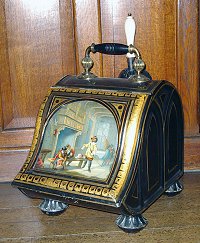 |
This coal vase does not have a maker's mark on it
but the shaped front has a reproduction of a painting behind a
glass panel and the shape might just be described as "somewhat
in the shape of a nautilus shell". Further it is in
Bantock House, Wolverhampton. It may be tentatively
ascribed to Jones Bros. But Angeline Johnson points out
that the general shape is almost identical to a coal box by
Henry Loveridge, as are the feet. William says that
new-shaped vases of similar design were then produced by many
other japanning houses and became very popular. It may be that
Loveridge's, or another firm, produced this version. |
Certainly it seems, from those still remaining,
that the Victorians produced a vast number of coal containers,
and lavished much care and attention on their design. Even
Christopher Dresser designed some. Henry Fearncombe had
produced enamelled coal scuttles for the 1851 exhibition, and
these, by the taste of the times, could not be called "ugly
articles". Perhaps what the Jones Brothers were first to do was
to fit a lid to cover the coal.
William says that "Soon after the death of Harry Jones [1871],
the manufacture of sheet-iron (and afterwards steel) travelling
trunks was introduced into the tin and japan trade by Jones
Brothers & Co. Before that time travelling trunks were usually
made of wood, covered with black canvas and studded with
brass-headed nails." William points out that travel, both
within the country and abroad, was greatly increasing in the
latter half of the nineteenth century and this created an
enormous trade in trunks. Many Wolverhampton firms joined in
this trade and no doubt Jones Brothers profited greatly by it.
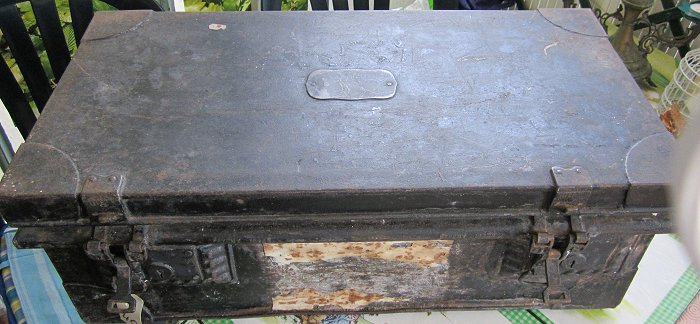
A watertight 'Jaybeco' trunk, courtesy
of Patrick Lainé, who purchased it a few years ago in Nice,
on the French Riviera. |
|
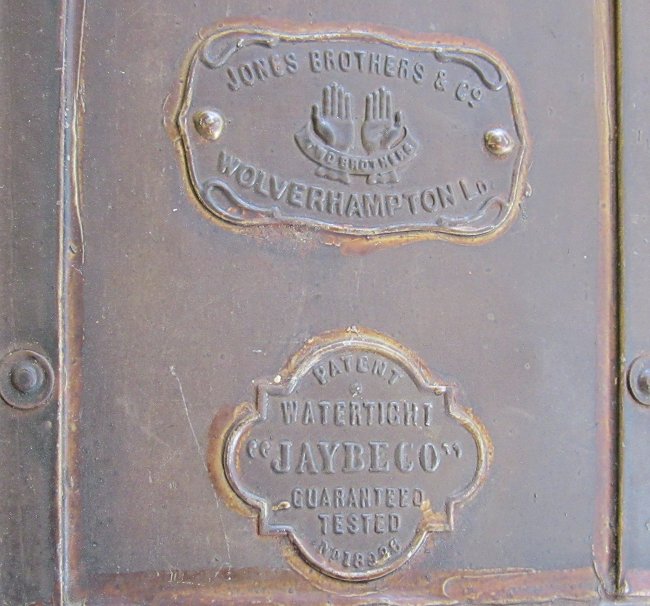
The name plate on Patrick Lainé's
trunk. |
| This photo of a Jones Bros trunk has kindly been
provided by Steve McLean, who has it in his shed in
Australia. (You never know what you might find in
Australia's iconic sheds). It may well have found its
way to Australia with British immigrants. |
 |
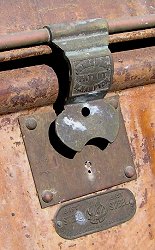 |
The unusually elaborate locking bar is marked at the top
"Jones Bros/Patent/W.hampton"; and below with the words
"Best Steel" on each side of the firms usual two hands trade
mark with the word "Jones Brothers Wolverhampton"
underneath. |
| This uniform case is named on a label inside as
the Owomeji Steel Uniform Case. The case itself and all
the locks are marked with Jones Bros patent numbers. The
case has been painted red and then black. While the black
was still wet a flat ended stick has been used to make crescent
shaped marks, revealing the red beneath, all over the top and
three sides. |
 |
These cases were intended for use in West Africa where, it was
thought, the crescent shapes were considered a good luck symbol.
This example still bears luggage labels referring to its transport by
Nigerian Railways. A similar uniform case was made by the Crown
Nail Company as “Niger” brand steel trunks and uniform cases under
the name of “Chatham Metal Products Limited”. They seem to have been a
rather better fitted out and higher quality product. But the
examples from two manufacturers indicate the importance and size of what
might seem to be a rather specialised market.
 |
This "Bombay Despatch Box" was advertised in
Gamages catalogue of 1914. Presumably it was intended for
use by "box wallahs" in India. |
|
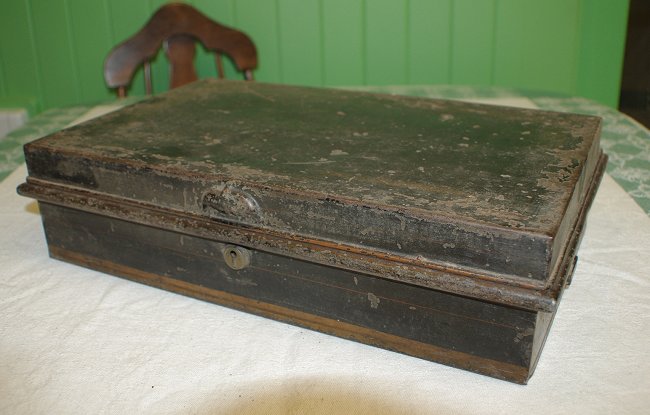
A Jones Brothers Bombay Despatch Box. Courtesy of Michael Kaehn. |
|
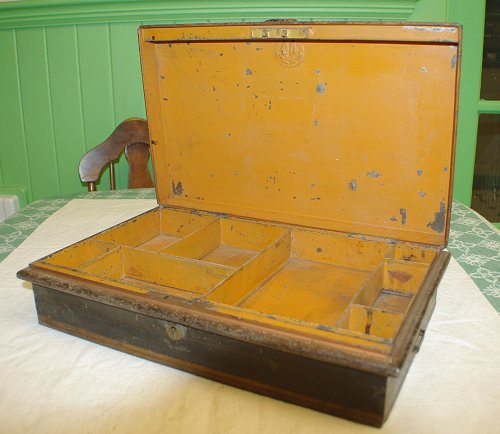
Another view of Michael Kaehn's fine Bombay Despatch Box. |
The company probably made almost any sheet metal item for which they
could find a market. Cash boxes were certainly one of their lines.
| This small cash box, which is fitted out with
lidded trays inside, was probably a standard line. This
one is of quite good quality, at least as far as the gilding is
concerned. |
 |
 |
The interior of the cash box above is elaborately
marked, with the words "Jones Bros Wolverhampton" circling the
gilded washers under the handle retaining nuts; and the two
hands symbol stamped between. |
| This large cash box is even more upmarket, with a
cast brass and engraved handle plate, rounded front and back
edges and a lavish use of gilding. It was probably
intended for use in the home or a director's office, rather than
for ordinary shop work. |
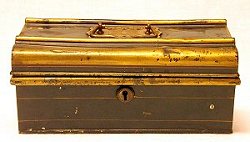 |
Jones Brothers seem to have made a wide range of items in tin plate
and in brass and copper. Not many have so far been identified,
which may, perhaps, indicate that their production was not great or
simply that they often did not mark their wares. They produced
some brass and copper wares which can be included under the heading "art
metalware".
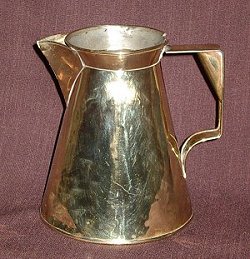 |
This jug bears the mark shown below. The
handle shows some style and an interesting attempt to provide a
(cheaper?) alternative to the usual tubular handle. But
the spout is poorly made and attached and the whole looks squat
and ugly. |
| The trade mark shown on the jug above. As it
refers to two brothers, the mark presumably dates from after the
death of Harry Jones in 1871. |
 |
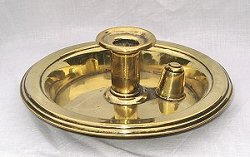 |
This chamber stick is of an unusual design, not
least in that it has no handle. And the extinguisher
screws onto a post in the well - which is very neat until you
try to replace the extinguisher after you have put out the
candle and are in the dark. But the whole seems to be well
made. |
| This mark appears on the chamber stick above.
It refers to Jones Bros as patentees - perhaps they patented the
screw down extinguisher. The royal coat of arms is not
significant - many Victorian manufacturers used it with no
warrant whatsoever. |
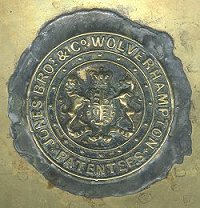 |
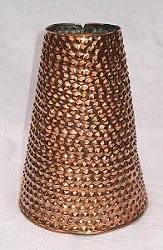 |
This weird object was sold by an antique dealer as
a vase. It may have been. But on the other hand it
only needs a handle and a spout to be a very standard type of
water jug. There is no sign of either of those ever having
been attached, so who knows? The mark on this item is
simply the words "Warranted hand wrought /Jones Bros & Co"
impressed in sans serif letters.
The best that can be said of the decoration is that the
knobbly things are vaguely reminiscent of the faceted studs
which were used extensively in Wolverhampton made steel
jewellery. |
| A coal scuttle of a very common design and showing
no signs of the lids about which W H Jones wrote so fulsomely.
But no doubt there continued to be a demand for the open bucket
type, which would have been much cheaper. |
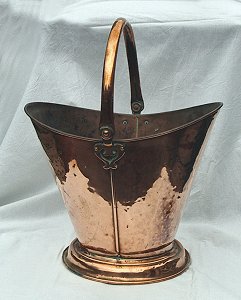 |
 |
It seems that everyone had to produce a copper
kettle and this is one attempt at it by Jones Bros. The
decoration is restrained - which would have saved costs but
which also makes it rather neat and pleasing. |
| Most, if not all, companies produced ewers.
These seem to have been, invariably, of a conical shape.
This is the only exception seen so far. It is also
different from the usual in combining brass and copper and in
having a cast brass twisted handle. The brass bands
carried an unusual decoration (see detail below). This and
the knobbly vase (above) suggest that Jones Bros had an
enthusiasm for design and for making something distinctive.
It may be thought that these efforts were not always completely
successful. |
 |
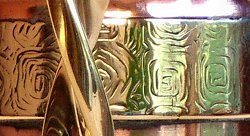 |
The design on the brass bands, near the handle,
where much polishing has not rubbed them off. |
| The jug above carries this mark in the base.
It seems likely that Jones Bros started using the two hands mark
after the death of the third brother, Harry, in 1871. The
letters "W.H." which appear here may just indicate "William
Highfield", the last surviving brother. |
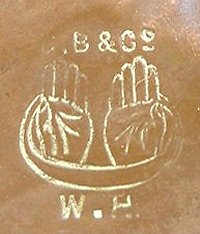 |
 |
This label, in imitation of a postage stamp, was
presumably used on envelopes and perhaps on other documents as
well. Showing the two brothers as Georgian gents was
probably an idea of the producers of the label, and was harking
back to the old days when things, undoubtedly, were much better. |
It is quite likely that Jones Bros moved into brass and copperware when
everyone else in the town was doing so: a market had opened up.
But their bread and butter work was almost certainly in manipulating
sheet metal.
|

|

|
|
Return to the
beginning |
Return to
metalware manufacturers |
|























